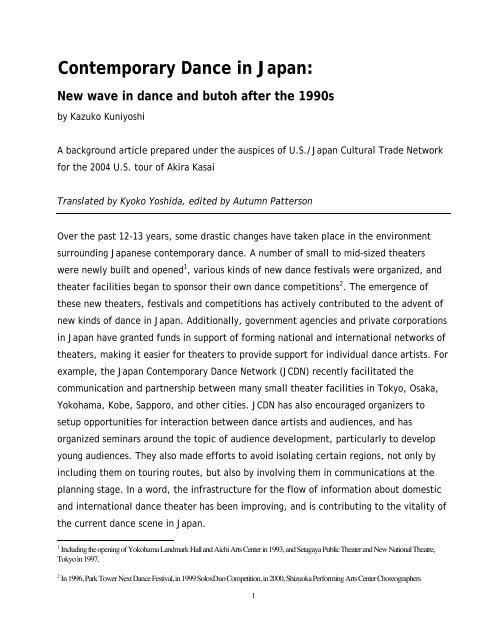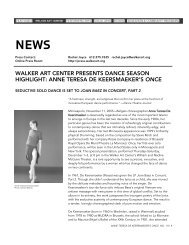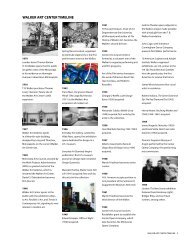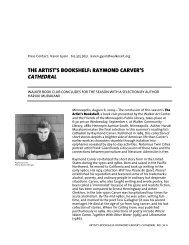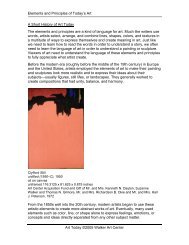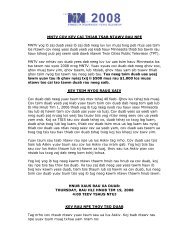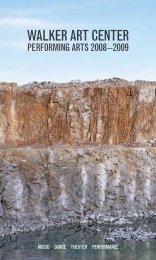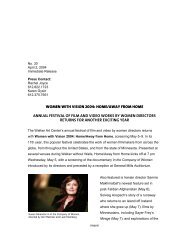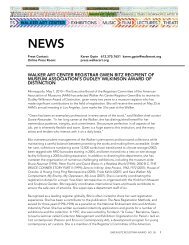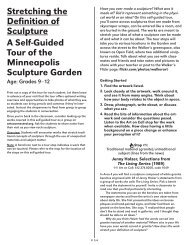Contemporary Dance in Japan: - Walker Art Center
Contemporary Dance in Japan: - Walker Art Center
Contemporary Dance in Japan: - Walker Art Center
Create successful ePaper yourself
Turn your PDF publications into a flip-book with our unique Google optimized e-Paper software.
<strong>Contemporary</strong> <strong>Dance</strong> <strong>in</strong> <strong>Japan</strong>:<br />
New wave <strong>in</strong> dance and butoh after the 1990s<br />
by Kazuko Kuniyoshi<br />
A background article prepared under the auspices of U.S./<strong>Japan</strong> Cultural Trade Network<br />
for the 2004 U.S. tour of Akira Kasai<br />
Translated by Kyoko Yoshida, edited by Autumn Patterson<br />
Over the past 12-13 years, some drastic changes have taken place <strong>in</strong> the environment<br />
surround<strong>in</strong>g <strong>Japan</strong>ese contemporary dance. A number of small to mid-sized theaters<br />
were newly built and opened 1 , various k<strong>in</strong>ds of new dance festivals were organized, and<br />
theater facilities began to sponsor their own dance competitions 2 . The emergence of<br />
these new theaters, festivals and competitions has actively contributed to the advent of<br />
new k<strong>in</strong>ds of dance <strong>in</strong> <strong>Japan</strong>. Additionally, government agencies and private corporations<br />
<strong>in</strong> <strong>Japan</strong> have granted funds <strong>in</strong> support of form<strong>in</strong>g national and <strong>in</strong>ternational networks of<br />
theaters, mak<strong>in</strong>g it easier for theaters to provide support for <strong>in</strong>dividual dance artists. For<br />
example, the <strong>Japan</strong> <strong>Contemporary</strong> <strong>Dance</strong> Network (JCDN) recently facilitated the<br />
communication and partnership between many small theater facilities <strong>in</strong> Tokyo, Osaka,<br />
Yokohama, Kobe, Sapporo, and other cities. JCDN has also encouraged organizers to<br />
setup opportunities for <strong>in</strong>teraction between dance artists and audiences, and has<br />
organized sem<strong>in</strong>ars around the topic of audience development, particularly to develop<br />
young audiences. They also made efforts to avoid isolat<strong>in</strong>g certa<strong>in</strong> regions, not only by<br />
<strong>in</strong>clud<strong>in</strong>g them on tour<strong>in</strong>g routes, but also by <strong>in</strong>volv<strong>in</strong>g them <strong>in</strong> communications at the<br />
plann<strong>in</strong>g stage. In a word, the <strong>in</strong>frastructure for the flow of <strong>in</strong>formation about domestic<br />
and <strong>in</strong>ternational dance theater has been improv<strong>in</strong>g, and is contribut<strong>in</strong>g to the vitality of<br />
the current dance scene <strong>in</strong> <strong>Japan</strong>.<br />
1<br />
Includ<strong>in</strong>g the open<strong>in</strong>g of Yokohama Landmark Hall and Aichi <strong>Art</strong>s <strong>Center</strong> <strong>in</strong> 1993, and Setagaya Public Theater and New National Theatre,<br />
Tokyo <strong>in</strong> 1997.<br />
2 In 1996, Park Tower Next <strong>Dance</strong> Festival, <strong>in</strong> 1999 SoloxDuo Competition, <strong>in</strong> 2000, Shizuoka Perform<strong>in</strong>g <strong>Art</strong>s <strong>Center</strong> Choreographers<br />
1
This period of rapid change co<strong>in</strong>cides with the period approximately 15 years after the<br />
death of Tatsumi Hijikata, the founder of butoh, when there was a significant change <strong>in</strong><br />
the art form. Some contemporary dancers, such as Saburo Teshigawara, Kim Itoh and<br />
Kota Yamazaki partially overlap the butoh generation, hav<strong>in</strong>g appeared on the scene <strong>in</strong><br />
the late 1980s. However, most of the dancers who are <strong>in</strong> their prime today <strong>in</strong> the<br />
contemporary <strong>Japan</strong>ese dance scene have had little, if any, <strong>in</strong>teraction with butoh. In<br />
order to fully understand the current trends <strong>in</strong> contemporary dance <strong>in</strong> <strong>Japan</strong>, it is<br />
important to ask ourselves, how is butoh, which widely changed the concept of dance <strong>in</strong><br />
the late 20 th century, reflected or not reflected <strong>in</strong> contemporary dance <strong>in</strong> <strong>Japan</strong> today.<br />
From its very beg<strong>in</strong>n<strong>in</strong>g, butoh was supposed to be a contemporary dance. However,<br />
when we exam<strong>in</strong>e the word “contemporary” <strong>in</strong> terms of today’s dance market, where<br />
the support system is rapidly develop<strong>in</strong>g and demand<strong>in</strong>g new forms of dance, we must<br />
say that the def<strong>in</strong>ition of “contemporary” has changed much s<strong>in</strong>ce the <strong>in</strong>itial <strong>in</strong>ception of<br />
butoh. In this article, I shall first review the history of butoh, and then discuss the issue<br />
of contemporary dance <strong>in</strong> <strong>Japan</strong> by closely look<strong>in</strong>g at Akira Kasai, one of the most<br />
<strong>in</strong>terest<strong>in</strong>g dance artists today.<br />
Emergence of Butoh<br />
What is regarded as butoh today is a physical expression born out of “Ankoku butoh<br />
(<strong>Dance</strong> of Darkness),” which emerged from <strong>Japan</strong>ese contemporary dance after World<br />
War II, and became prom<strong>in</strong>ent dur<strong>in</strong>g the 1970s and 80s. When Tatsumi Hijikata (b. 1928<br />
<strong>in</strong> Akita – d. 1986 <strong>in</strong> Tokyo) began creat<strong>in</strong>g his own works at the end of the 1950s, he<br />
aggressively <strong>in</strong>corporated socially taboo themes of sex and violence <strong>in</strong>to his work,<br />
present<strong>in</strong>g a so-called “rebellion of the human body,” break<strong>in</strong>g the control of modern<br />
reason<strong>in</strong>g and constantly creat<strong>in</strong>g scandals. Hijikata broke away from the control of<br />
modern logic by fac<strong>in</strong>g the negative side of human be<strong>in</strong>gs, an aspect that had not been<br />
dealt with before <strong>in</strong> contemporary dance. (Hence the name “ankoku butoh” or “dance of<br />
darkness.”) He attempted to recapture the concept of the physical body not simply as a<br />
tool to convey certa<strong>in</strong> l<strong>in</strong>guistic mean<strong>in</strong>g, but as an entity that owns its own time and<br />
Competition, <strong>in</strong> 2001 Asahi Perform<strong>in</strong>g <strong>Art</strong>s Award, <strong>in</strong> 2002, Toyota Choreography Award were <strong>in</strong>itiated respectively.<br />
2
space. In other words, Hijikata felt that the physical body demanded a new expression<br />
that did not exist before on stage. He was seen as a heretic <strong>in</strong> the contemporary dance<br />
community <strong>in</strong> <strong>Japan</strong>, but went on to develop ankoku butoh at a time when a new<br />
movement was happen<strong>in</strong>g <strong>in</strong> the contemporary visual arts world, as well. Hijikata<br />
avariciously absorbed these avant-garde trends <strong>in</strong> the arts world through his <strong>in</strong>teractions<br />
with artists <strong>in</strong> the field of literary and visual arts.<br />
With a series of cont<strong>in</strong>uous performances, “Shik<strong>in</strong>o tameno 27ban” (27 Nights for Four<br />
Seasons)” presented <strong>in</strong> 1972 3 , Hijikata made a breakthrough performance and<br />
established an art form that would be passed down as his own. In this piece, Hijikata<br />
redef<strong>in</strong>ed the concept of physical body with his view that the human body was a<br />
conta<strong>in</strong>er of enormous memories, from childhood to the moment just before one’s<br />
death. Techniques such as te-boke (absent m<strong>in</strong>ded hands), <strong>in</strong> which the dancer lets their<br />
hands wander anxiously <strong>in</strong> the air with no practical purpose, and gani mata (bandy legs),<br />
<strong>in</strong> which the body lowers the center of gravity, both of which were totally unheard of <strong>in</strong><br />
the history of Western dance, were gradually established as techniques specific to<br />
Hijikata’s butoh. These techniques were developed ma<strong>in</strong>ly by women and were very<br />
powerful forms of expression for the lower body. This particular series of works by<br />
Hijikata, which seem<strong>in</strong>gly emphasized the geographical climate of Tohoku [Northeastern<br />
<strong>Japan</strong>] were also called “Tohoku Kabuki.” They were seen as an effort to rediscover the<br />
physicality of <strong>Japan</strong>ese people, which had been left beh<strong>in</strong>d <strong>in</strong> the process of<br />
modernization after the Meiji restoration. These techniques were labeled as “pre-<br />
modern” or “super-modern” and thus were regarded as a criticism to modernity. In this<br />
way, Hijikata’s Tohoku Kabuki can be seen as the beg<strong>in</strong>n<strong>in</strong>gs of the post-modern dance<br />
movement <strong>in</strong> <strong>Japan</strong>.<br />
Look<strong>in</strong>g back at the history of Western-style dance <strong>in</strong> <strong>Japan</strong>, various techniques of<br />
contemporary dance were developed from those of German and American contemporary<br />
dance, up to this po<strong>in</strong>t. It is no exaggeration to say that <strong>Japan</strong>ese contemporary dance<br />
has <strong>in</strong>tricately evolved, pil<strong>in</strong>g up only the Western techniques without sufficient<br />
3 At the <strong>Art</strong> Theater Sh<strong>in</strong>juku Bunka <strong>in</strong> October, 1972.<br />
3
understand<strong>in</strong>g of the context beh<strong>in</strong>d them. Hijikata, by present<strong>in</strong>g his ill, wither<strong>in</strong>g, old<br />
and emaciated body, made powerful criticism on the exist<strong>in</strong>g expression and its context.<br />
Hijikata's theory <strong>in</strong>cluded a paradoxical structure that the expressions are not valid until<br />
deconstruct<strong>in</strong>g not just the theory of dance, but of human existence itself.<br />
In the 1960s when Hijikata's ankoku butoh was start<strong>in</strong>g to ga<strong>in</strong> attention from a small<br />
group of people <strong>in</strong> <strong>Japan</strong>, post-modern dance started to catch people's attention <strong>in</strong> the<br />
U.S. In <strong>Japan</strong>, such dancers as Bonj<strong>in</strong> Atsugi and Suzushi Hanayagi, who were <strong>in</strong>fluenced<br />
heavily by the m<strong>in</strong>imalism of American post-modern dance, brought <strong>in</strong> this new w<strong>in</strong>d to<br />
the dance world. Atsugi, <strong>in</strong> particular, witnessed the progressive new movement <strong>in</strong><br />
dance evolv<strong>in</strong>g around the Judson <strong>Dance</strong> Theater <strong>in</strong> New York City dur<strong>in</strong>g the mid-1960s.<br />
Prior to liv<strong>in</strong>g <strong>in</strong> New York City, Atsugi created works based on the dance classics 4 , but<br />
after the <strong>in</strong>fluence of the Judson <strong>Dance</strong> Theater, his works began to <strong>in</strong>clude more<br />
repeated, cont<strong>in</strong>uous movements that were carefully selected and <strong>in</strong>herited as ballet<br />
steps or limited simple actions. As a result, the formation and emotional aspects of the<br />
storyl<strong>in</strong>es were completely shut out, and <strong>in</strong>stead, physical conditions and expressions<br />
themselves were vividly presented. Atsugi is <strong>in</strong> the same generation as Hijikata, but<br />
pioneered the post-modern dance movement <strong>in</strong> <strong>Japan</strong> with totally different concepts,<br />
and his contribution should really be more widely recognized than it is today.<br />
Kazuo Ohno, another butoh artist who supported the art form, was 20 years senior to<br />
Hijikata and Atsugi, and had already established a career as a modern dancer, hav<strong>in</strong>g<br />
studied under the schools of German expressionism dance <strong>in</strong> the 1930s. Ohno met with<br />
Hijikata <strong>in</strong> the 1950s and, although their styles differed greatly, Ohno became an<br />
<strong>in</strong>dispensable perform<strong>in</strong>g partner <strong>in</strong> many of Hijikata’s works. He then disappeared from<br />
the performance stage for a while, miraculously return<strong>in</strong>g when he was 70 years old with<br />
Admir<strong>in</strong>g La Argent<strong>in</strong>a a piece dedicated to Spanish master dancer Antonia Merce.<br />
Follow<strong>in</strong>g this come-back, Ohno performed such pieces as Watash<strong>in</strong>o Okasan (My<br />
Mother) and Shikai (Dead Sea), directed by Hijikata. After Hijikata’s death, Ohno<br />
cont<strong>in</strong>ued to create a number of works with his son, Yoshito Ohno. Today, Kazuo Ohno is<br />
4 th<br />
Another name for ballet. Ballet technique based on five foot positions, <strong>in</strong>vented at the Royal Academy of Music <strong>in</strong> Paris <strong>in</strong> the 17 century..<br />
4
98 years old. As such, he cannot hide the weakness of his ag<strong>in</strong>g body, but he still<br />
performs as a butoh artist <strong>in</strong> his wheelchair. Ohno says that to live and to perform butoh<br />
need to be experienced with exactly equal weight. He has touched many people world<br />
wide with his commitment and determ<strong>in</strong>ation to dance for as long as he lives.<br />
The advent of Akira Kasai<br />
Study<strong>in</strong>g under Kazuo Ohno, Akira Kasai came <strong>in</strong>to the <strong>Japan</strong>ese contemporary dance<br />
scene <strong>in</strong> the 1960s. After his encounters with Ohno and Hijikata, Kasai proceeded to<br />
create an orig<strong>in</strong>al butoh world for himself. He founded Tenshi-kan (House of the Angels)<br />
<strong>in</strong> 1971 and, besides creat<strong>in</strong>g his own works, has also been earnest <strong>in</strong> teach<strong>in</strong>g his<br />
followers. He is active as a researcher of eurythmics, a movement-art theory established<br />
by Rudolf Ste<strong>in</strong>er, a German philosopher who also founded the philosophy of<br />
anthroposophy. In recent years, Kasai has been actively collaborat<strong>in</strong>g with new wave<br />
contemporary dancers, push<strong>in</strong>g the envelope of the exist<strong>in</strong>g concept of butoh to<br />
cultivate a new realm of expression.<br />
Before the 1970s, Kasai’s butoh had a clear direction of gett<strong>in</strong>g close to spiritual<br />
existence by sublimat<strong>in</strong>g the physical body and exhaust<strong>in</strong>g it with dance. After<br />
complet<strong>in</strong>g his butoh thesis, Tenshi-ron (Theory of Angels) <strong>in</strong> 1972, Kasai went to<br />
Germany with the purpose of study<strong>in</strong>g Ste<strong>in</strong>er’s theories. He stayed <strong>in</strong> Germany for 7<br />
years before return<strong>in</strong>g to <strong>Japan</strong> and, <strong>in</strong> the years follow<strong>in</strong>g his return, dedicated his<br />
efforts to further<strong>in</strong>g the Ste<strong>in</strong>er research, promot<strong>in</strong>g eurythmics, and perform<strong>in</strong>g aga<strong>in</strong> <strong>in</strong><br />
<strong>Japan</strong>. In the summer of 1996, Kasai conducted a U.S. tour and, from this time on, his<br />
works saw notable changes. Kasai stopped present<strong>in</strong>g his works as secret cult rituals,<br />
which was previously the signature of his butoh works. Instead, he began to <strong>in</strong>teract with<br />
the outside world by collaborat<strong>in</strong>g with other contemporary dance artists <strong>in</strong> both<br />
choreography and performance.<br />
His dance works became very easy to understand, as if he was declar<strong>in</strong>g the new<br />
direction for the ma<strong>in</strong>stream audience, go<strong>in</strong>g along with the social trend. This change<br />
can be clearly seen <strong>in</strong> his duo work with Kuniko Kisanuki, a contemporary dance artist, <strong>in</strong><br />
5
the work titled, Yes, No, Yes, No which premiered <strong>in</strong> 1999. Kisanuki is not the k<strong>in</strong>d of<br />
dance artist who would make works us<strong>in</strong>g exist<strong>in</strong>g dance vocabulary. Kasai’s encounter<br />
with Kisanuki unearthed his secret world of butoh performed as ritual, br<strong>in</strong>g<strong>in</strong>g him out<br />
<strong>in</strong>to the light of the ma<strong>in</strong> stage of metropolitan public theaters. Yes, No, Yes, No was a<br />
stunn<strong>in</strong>g duo work <strong>in</strong> which the sharp, gallant, boyish movement of Kisanuki and the<br />
<strong>in</strong>cessant, unruly and agitat<strong>in</strong>g movement of Kasai crisscrossed with dazzl<strong>in</strong>g speed.<br />
In the year 2000, Kasai formed Akira Kasai <strong>Dance</strong> Unit, and performed with Kisanuki,<br />
Ryohei Kondo, Yoko Ando, Naoka Uemura and others <strong>in</strong> their 20s and 30s, who were <strong>in</strong><br />
their prime as dancers and full of energy. 5 Appear<strong>in</strong>g on stage, his hair blonde and<br />
wear<strong>in</strong>g sunglasses, Kasai danced through the whole piece with astonish<strong>in</strong>g stam<strong>in</strong>a.<br />
Usually, someone who performs freestyle can only do so for five m<strong>in</strong>utes before their<br />
movement vocabulary dries out, and ends up becom<strong>in</strong>g repetitive. However, there was<br />
no such banal repetition <strong>in</strong> Kasai’s freestyle. The audience could not predict his next<br />
movement at all, and were cont<strong>in</strong>uously shocked by his unexpected movement. To my<br />
astonishment, also, all of his movements that, at a glance, seemed like a series of<br />
<strong>in</strong>stantaneous improvisational movements were actually choreographed to each and<br />
every hand and foot movement. All of the musical pieces for the work had strong beats<br />
and rhythms and were abstract pieces with no conventional melody. Kasai also actively<br />
<strong>in</strong>corporated elements of street dance, <strong>in</strong>clud<strong>in</strong>g hip-hop <strong>in</strong>to his pieces. The dash<strong>in</strong>g<br />
impetus of the compet<strong>in</strong>g structure rejects any room for a story l<strong>in</strong>e to be developed by<br />
the audience. There is not a moment of stagnation <strong>in</strong> his work.<br />
In April 2001, Kasai premiered Kafun Kakumei (Pollen Revolution) as part of Theater<br />
Trum’s solo series. In the open<strong>in</strong>g scene, the audience was astonished by his entrance<br />
wear<strong>in</strong>g the full costume of the young maiden from Kyokanoko Musume Dojoji, one of<br />
the most famous kabuki dance pieces. Kasai presented the complete image of the young<br />
maiden, formidably clad <strong>in</strong> the costume from Musume Dojoji at the open<strong>in</strong>g of the piece<br />
then started to destroy it from <strong>in</strong>side out. Wear<strong>in</strong>g the kimono and a traditional<br />
<strong>Japan</strong>ese wig, Kasai danced frantically to the music of “Dojoji,” sw<strong>in</strong>g<strong>in</strong>g up the dangl<strong>in</strong>g<br />
5 “Sp<strong>in</strong>n<strong>in</strong>g Spiral Shak<strong>in</strong>g Strobe” <strong>in</strong> 2000.<br />
6
kimono sleeves, flutter<strong>in</strong>g the bottom of the dragg<strong>in</strong>g kimono, slovenly widen<strong>in</strong>g the<br />
collar, oblivious of the kimono loosen<strong>in</strong>g and go<strong>in</strong>g out of shape. He danced <strong>in</strong>cessantly<br />
with stunn<strong>in</strong>g energy and concentration, as if spread<strong>in</strong>g out <strong>in</strong>to all directions <strong>in</strong>f<strong>in</strong>itely<br />
with his elaborate costume. The image did not <strong>in</strong>voke any semblance of the human body.<br />
He danced as if he was smash<strong>in</strong>g his whole body <strong>in</strong>to pieces.<br />
In 2003, Kasai choreographed and directed G<strong>in</strong>ga Keikaku (Galaxy Plan) and performed<br />
with Kim Itoh. It was his peculiar metaphor to derive the story of Ca<strong>in</strong> and Abel from the<br />
Old Testament for the structure of the work. Through his works Kasai attempts to derive<br />
the spiritual world that has built up the modern society, us<strong>in</strong>g various metaphors<br />
paradoxically, reviv<strong>in</strong>g it <strong>in</strong>to a form, validat<strong>in</strong>g and accept<strong>in</strong>g it for once through his<br />
physical body, then, the next moment, destroy<strong>in</strong>g its structure from the <strong>in</strong>side out with<br />
enormous impetus. This can be seen as a major characteristic of his recent works.<br />
From butoh go<strong>in</strong>g beyond <strong>Japan</strong> to the Post-Butoh movement<br />
It was when butoh was presented at the 14 th Nancy International Theater Festival <strong>in</strong> 1980<br />
that the art form that had been a m<strong>in</strong>or artistic expression <strong>in</strong> <strong>Japan</strong> was officially<br />
<strong>in</strong>troduced to Western audiences. 6 The <strong>in</strong>ternational popularity of butoh owes its<br />
foundation to the activities of such artists and groups as Kazuo Ono, Sankai Juku and<br />
Sebi. 7 As the reputation of butoh grew outside of <strong>Japan</strong>, it ironically made its way back<br />
<strong>in</strong>to <strong>Japan</strong> to be <strong>in</strong>troduced to the ma<strong>in</strong> stream <strong>in</strong> 1985 -- Butoh Festival ‘85 was held <strong>in</strong><br />
Tokyo organized by Nihon Bunka Zaidan (Nippon Cultural <strong>Center</strong>). Thus, butoh, regarded<br />
as one of the contemporary dances of <strong>Japan</strong>, stimulated and <strong>in</strong>fluenced dance and<br />
theaters <strong>in</strong> the U.S. and Europe, and its popularity encouraged other contemporary<br />
dances of <strong>Japan</strong> to be exported actively abroad. Around this time, with the advent of<br />
P<strong>in</strong>a Bausch’s Tanz Theater and the French Nouveau dance 8 , German and French<br />
contemporary dance began to attract the public’s attention. Butoh was accepted <strong>in</strong> this<br />
context <strong>in</strong> Europe as a shock<strong>in</strong>g physical expression totally different from that of the<br />
Western dance.<br />
6<br />
To be accurate, Koh Murobushi and others performed <strong>in</strong> 1978 at Nouveau College <strong>in</strong> Paris, which should be considered as the European<br />
premiere of butoh.<br />
7<br />
M<strong>in</strong> Tanaka was perform<strong>in</strong>g abroad as well but did not call his dance “butoh.”<br />
7
Then, <strong>in</strong> 1986, as if to replace the death of Hijikata, Saburo Teshigawara came onto the<br />
scene. Teshigawara’s dance form was referred to as “post-butoh,” <strong>in</strong>dicat<strong>in</strong>g that it was<br />
regarded as the birth of a new k<strong>in</strong>d of dance <strong>in</strong> <strong>Japan</strong>. Teshigawara kept a certa<strong>in</strong><br />
distance from the contemporary dance community <strong>in</strong> <strong>Japan</strong>, and from butoh as well. He<br />
was the first <strong>Japan</strong>ese dancer to w<strong>in</strong> at the Concours de Choregraphique de Bagnoloet <strong>in</strong><br />
1986, and his dance then became the second <strong>Japan</strong>ese contemporary dance form to be<br />
<strong>in</strong>troduced to the world after butoh. His dance was different from the mysterious<br />
symbolism of Sankai Juku, the group that was active <strong>in</strong> Europe and the United States<br />
then, or from the expressive butoh of Kazuo Ohno. It was also different from that of<br />
Dairakudakan’s erotic physicality and festive stage presence. Teshigawara’s dance was<br />
highly regarded as it directly reflected the sensitive receptivity of contemporary<br />
metropolitan lives, and opened up new possibilities for dance <strong>in</strong> the post-butoh age.<br />
Development of the New Wave and Kasai<br />
Teshigawara’s dance aroused a new awareness for the physicality <strong>in</strong> dance, <strong>in</strong>clud<strong>in</strong>g<br />
movements from everyday motion and mimes to acrobatics, which up until this time, had<br />
not been a large part of dance <strong>in</strong> <strong>Japan</strong>. Critical discussions regard<strong>in</strong>g body became<br />
active <strong>in</strong> the context of dance. In addition, digital images of bodies through computer<br />
assistance, entered <strong>in</strong>to the dance world. It can be said that a new image of the human<br />
body was <strong>in</strong> demand along with the expansion of human perception.<br />
M<strong>in</strong> Tanaka’s works are expressive, <strong>in</strong>tend<strong>in</strong>g to present the idea that the body generates<br />
its own stories, as opposed to be<strong>in</strong>g a tool of tell<strong>in</strong>g exist<strong>in</strong>g stories, by trac<strong>in</strong>g back the<br />
perception and memories of one’s body. This is the basic stance of butoh works.<br />
There are also groups such as H. <strong>Art</strong> Chaos, lead by Sakiko Oshima, and Nomado’s lead by<br />
Nakao Ikemiya, whose works are expressive but have no relation to butoh for their roots.<br />
Oshima, <strong>in</strong> particular, dares to put a physical body <strong>in</strong> a fantasy world with her bold<br />
choreography match<strong>in</strong>g the spectacular aesthetics of the stage and deriv<strong>in</strong>g astonish<strong>in</strong>g<br />
8 Specifically refers to the French new wave dance of the 1980s.<br />
8
concentration from dancer Naoko Shirakawa’s performance.<br />
Popular culture, which had then been actively <strong>in</strong>corporated <strong>in</strong>to contemporary dance,<br />
also gave birth to a dance <strong>in</strong> which the dancer’s body reflects the youth culture of<br />
contemporary metropolitan <strong>Japan</strong>ese society, known as “J-dance.” For example, <strong>in</strong> the<br />
works of Nibroll (lead by Mikuni Yanaihara) we see a body which suddenly snaps and<br />
explodes after feel<strong>in</strong>g cont<strong>in</strong>uous stress and, <strong>in</strong> contrast, Strange K<strong>in</strong>oko <strong>Dance</strong> Company<br />
(lead by Chie Itoh), presents a fluid physicality of happy young girls that flow nimbly and<br />
swiftly through daily life.<br />
In contrast, Kim Itoh is another dance artist who explores a new way of communication<br />
with the audience by express<strong>in</strong>g humor born from the gap between obsessive<br />
concentration of perception on stage and the reality of normal, every day life. Condors<br />
(lead by Ryohei Kondo) and Idevian Crew (lead by Shigehiro Ide) belong to a group called<br />
“owarai kei (comical school)” and pursue their enterta<strong>in</strong>ment l<strong>in</strong>e by <strong>in</strong>corporat<strong>in</strong>g<br />
mimeography and comedy <strong>in</strong>to their dances, creat<strong>in</strong>g a nonsensical world which defies<br />
explanation. The audience is encouraged to just sit back and enjoy the absolute<br />
nonsense and the comical dance itself.<br />
All of these so called “J-dance” artists create works <strong>in</strong>corporat<strong>in</strong>g various dance<br />
techniques 9 and ideas. One th<strong>in</strong>g that connects the J-dance artists is that their works<br />
reject discussion us<strong>in</strong>g established semantics. In order to avoid be<strong>in</strong>g consumed <strong>in</strong>to an<br />
overall story, J-dance artists construct their works by collect<strong>in</strong>g bits and pieces of<br />
unrelated scenes or us<strong>in</strong>g a multitude of simple, daily images.<br />
In contrast to the light-hearted and elusive characteristics of J-<strong>Dance</strong>, dancer Mika<br />
Kurosawa tries to create her expression as far as possible from the physicality developed<br />
under the conventional dance technique. Kurosawa agitates the audience by putt<strong>in</strong>g on<br />
costumes that <strong>in</strong>voke the world of gay show dance, or of certa<strong>in</strong> fairy tale characters.<br />
9 One can learn the basic techniques such as release technique, contact improvisation, butoh, capoeira, etc. by participat<strong>in</strong>g <strong>in</strong> ubiquitous dance<br />
9
Choreographers Tsuyoshi Shirai and Kaya Ohashi, try to recognize and reconstruct a new<br />
sense of body by appeal<strong>in</strong>g to various perceptions. These choreographers use their<br />
physical bodies without dance techniques as the tools of exploration, more common <strong>in</strong><br />
performance art, as they search for the roots of bodily movement.<br />
With<strong>in</strong> the above context of the development of contemporary <strong>Japan</strong>ese dance, butoh<br />
artist Akira Kasai stands <strong>in</strong> an extremely <strong>in</strong>terest<strong>in</strong>g position. As opposed to many of the<br />
contemporary dancers creat<strong>in</strong>g works based on one’s own physical perception (such<br />
condition as pleasant or unpleasant, for an example) Kasai sets his physical body <strong>in</strong> a<br />
strictly conceptual state, not <strong>in</strong> the state of real world perception, yet create dance<br />
works with the <strong>in</strong>tention to sublimate the physical body.<br />
The history of dance from the modern times to current was lead and <strong>in</strong>herited by<br />
<strong>in</strong>novative choreographers, butoh be<strong>in</strong>g the prime example. The history of contemporary<br />
<strong>Japan</strong>ese dance has been developed by those who seek the truth with cont<strong>in</strong>uous<br />
question<strong>in</strong>gs and denials of the exist<strong>in</strong>g concepts and conventional aesthetics. Butoh is<br />
not simply one certa<strong>in</strong> style of dance. And although we must respect the roots of butoh<br />
as it was developed by Tatsumi Hijikata, it would be unwise to take our eyes away from<br />
Akira Kasai, as he is just about to roll out the grand new possibilities of butoh for the<br />
post-modern age.<br />
© <strong>Art</strong>s Midwest 2004<br />
workshops.<br />
10


